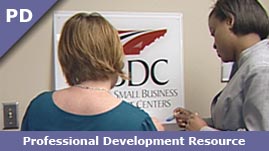Teachers' Domain - Digital Media for the Classroom and Professional Development
User: Preview

Source: Making Learning Real: "Course/Business Matching"
This media asset is from Making Learning Real: "Course/Business Matching."
This video from Making Learning Real shows how the Problem-Based Case Learning (PBCL) cycle begins with the Course/Business Matching stage. A Web design instructor contacts a local business center to match his class with a business partner. After the center suggests possible partners, the instructor approaches one—the owner of a local clothing boutique, who discusses her need for a Web site.
With Problem-Based Case Learning (PBCL), students acquire and apply subject knowledge and develop professional skills, all to solve a real-world business problem. The PBCL process unfolds in nine stages. The first stage is called Course/Business Matching, when the instructor looks for a business partner with a real problem to pose to the class. The partnership has mutual benefits: the class gets professional experience, while the business gets help (at no monetary cost).
In this video, the instructor defines his criteria for a business partner. He wants a partner who already has a business plan and can be available to the class during the PBCL process. The instructor uses a business center to find this partner.
Because the instructor has defined the criteria, his contact at the business center knows what to look for in a match. After agreeing to the partnership, formulating the problem, and posing the problem to students, the instructor and business partner continue the PBCL process with PBCL Stage 2: Framing.
 Loading Standards
Loading Standards